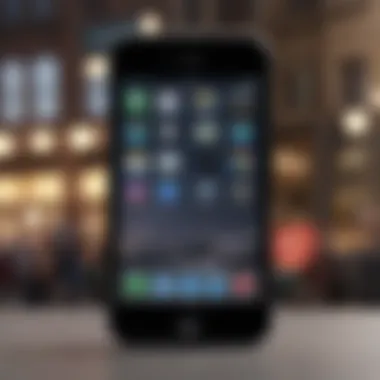The iPhone 5 Release: Transforming Mobile Technology


Intro
The introduction of the iPhone 5 in September 2012 marked a turning point in mobile technology, taking a significant leap from its predecessors. Before its arrival, there was palpable buzz in tech circles and consumer markets. With Apple having set the standard for smartphones, expectations were running high. Enthusiasts wanted to know how this new device would change their everyday lives.
Apple had crafted a narrative around the iPhone 5 blending sleek design with innovative features. From the moment it was announced, many speculated about how it would stack up against competitors in a rapidly evolving market. The year 2012 saw a surge of competition, making the stakes higher for Apple. They had to present a device that not only met but exceeded what consumers anticipated, proving that they weren't just leading the pack—but setting it.
In this context, let's delve deeper into the specifics of the iPhone 5, its characteristics, and how it set in motion a new era in the smartphone landscape.
Prelims
The release of the iPhone 5 in 2012 marked a watershed moment in the realm of mobile technology. As the world increasingly integrated smartphones into daily life, the iPhone 5 represented not only a step forward in device design but also a recalibration of consumer expectations.
With its sleek profile and advanced features, it captured the imagination of tech enthusiasts and everyday users alike. The significance of this release runs deeper than surface-level specifications; it brought about a shift in how we interact with technology. Enhanced performance, improved camera systems, and a striking design weren't simply upgrades; they were transformative changes that set new benchmarks within the smartphone industry.
The anticipation that built up towards the iPhone 5's launch was palpable. From rumors of specs leaked through dubious channels to Apple's own marketing blitz, it became a topic of conversation in tech circles and casual coffee shop chats. This buzz wasn't just noise; it indicated how intertwined the iPhone had become with modern consumer culture.
Moreover, the launch of iPhone 5 had significant ramifications for Apple as a brand. The device helped solidify Apple’s status at the forefront of the tech landscape and left competitors scrambling to catch up. In dissecting the various facets of this launch—ranging from pre-release speculations to its lasting impact—we gain essential insights into the evolution of mobile devices.
The iPhone 5 wasn’t merely an upgrade; it was a redefining moment for smartphones, merging form with function in a way that resonated with users worldwide.
The implications were vast: tech companies had to rethink their strategies, consumers began to shift their priorities when it came to mobile capabilities, and the standards for what constituted a high-performing smartphone were raised. This article seeks to illuminate these elements, helping readers appreciate why the iPhone 5 is regarded as a landmark in mobile technology. Throughout, we will provide an in-depth analysis of its historical context, the lead-up to its release, and the technological advancements it introduced, as well as the impact it created in the global market.
Historical Context of iPhone Releases
Understanding the historical context surrounding the release of the iPhone 5 serves as an essential foundation for grasping its pivotal role in mobile technology. It paints a picture of how Apple, a company already renowned for innovation, continued to shape the landscape of smartphones. Each iteration of the iPhone not only reflected advancements in technology but also acted as a mirror to the evolving consumer demands. This intricate backdrop enables us to appreciate the monumental leap represented by the iPhone 5 in a broader narrative of technological growth.
Evolution from Original iPhone to iPhone
When the original iPhone was launched in 2007, it was nothing short of revolutionary. It brought together a phone, an iPod, and an internet communicator into one sleek device. The user-friendly interface, coupled with the introduction of the App Store, marked a turning point for mobile devices. Over the years, each new model revealed Apple's response to competition and demand:
- iPhone 3G (2008) introduced 3G connectivity and GPS functionality.
- iPhone 4 (2010) boasted a high-resolution Retina Display and a new design language, departing from the plastic casing of earlier models.
- iPhone 4S (2011) brought Siri, revolutionizing how users interacted with their devices via voice command.
By the time the iPhone 5 was announced in 2012, Apple had accumulated invaluable insight regarding consumer expectations and technological limitations. The iPhone 5 was not only thinner and lighter but also included increased processing power, a larger screen, and the lightning connector remarkably signifying Apple’s commitment to continuous improvement. The evolution from previous models highlights not just innovation but adaptability, a characteristic that has set Apple apart in a dynamic tech ecosystem.
The Competitive Landscape in Early Two-Thousands
In the early 2000s, the smartphone domain was beginning to take off, but it wasn't the cut-and-dry market that many would assume. Companies like Nokia, Blackberry, and LG were at the forefront, each carving out segments of the market with distinct features. Nokia remained strong in hardware; Blackberry prioritised business features and security. Yet, neither had successfully fused a robust app ecosystem with user-friendly design in that they made use of physical keyboards and less touch-friendly interfaces.
Against this backdrop, Apple's iPhone strategies aimed for a consumer-friendly experience coupled with robust applications. The marketing was directed more toward lifestyle enhancements rather than as just another piece of technology. So when Apple released the iPhone 5, it didn't just step into the fray but rather set new standards that competitors scrambled to match.
As noted by technology analyst Matthew Greenwald, "With each release, Apple disrupted the norms established by earlier devices, leading competitors to rethink their designs and strategies." This ripple effect illustrates the layered complexity of competition in the mobile sector and underscores why the iPhone 5 was not merely another model for Apple but a clear defining moment in the evolution of smartphones.
"The iPhone 5 didn't just continue a legacy; it created a paradigm shift that competitors were keenly aware of."
In essence, understanding this historical context enriches our appreciation of the iPhone 5 as a transformative device within a constantly shifting technological landscape. Its development was not isolated; rather, it was a response to both the successes and shortcomings of its predecessors and rivals.
Anticipation Leading to Release
The anticipation surrounding the release of the iPhone 5 marked a turning point both for Apple and the mobile technology landscape. This period was characterized by a swirling mix of excitement, speculation, and sometimes, controversy. As the launch date approached, the air was thick with expectation. This buzz was not just a byproduct of Apple's reputation but also a reflection of changing consumer behavior in the smartphone market.
Pre-Release Speculations and Leaks
Before the official announcement, various leaks and rumors flooded the internet. Blogs, forums, and tech news sites were awash with speculative commentary on what the new iPhone might include. Some of these speculations were rooted in legitimate sources, while many others were pure conjecture.
- Design Changes: Rumors suggested that the iPhone 5 would feature a larger screen and a new design language, which would set it apart from its predecessors. This idea intrigued many users who were clamoring for larger displays in a world dominated by virtual communication.
- Technical Specifications: There were frequent discussions about improvements in battery life and memory. The buzz around a possible A6 chip hinted at significant performance upgrades, raising eyebrows among tech aficionados.
- 5G Capability: Although it was a bit premature, some leaks hinted at 5G capability, which many saw as a game changer for mobile internet connectivity.
These speculations fueled not only consumer excitement but also the market's response. Apple, as always, played its cards close to the chest. The carefully cultivated mystique around its product launches created a kind of frenzy that drove discussions—sometimes leading to misguided conclusions.


Apple’s Marketing Campaign
Apple's marketing strategies leading up to the iPhone 5 launch were well thought out and executed to perfection. They knew that in the crowded smartphone market, a unique approach was essential to differentiate the iPhone 5.
- Teasers and Cryptic Messaging: Apple utilized cryptic messaging and tantalizing teasers through social media and its website. This vagueness kept people guessing, inviting speculation and discussion. The ad campaigns would not disclose too many specifics but emphasized innovation, connection, and lifestyle enhancements.
- Event Hosting: The event announcing the iPhone 5 was not just a product launch; it was an experience. Invitations to the media and industry professionals hinted at a major reveal, and when the day came, it delivered with high production value. This approach was a standard for Apple, but the stakes felt particularly high this time around.
- Engagement Across Platforms: Utilizing channels like Facebook and Reddit, Apple fostered conversations about its products while also managing to direct the narrative. The way they engaged not only tapped into existing customer loyalty but also captured new audiences who were curious about the hype.
The marketing campaign addressed the needs and desires of tech enthusiasts, from needing cutting-edge technology to wanting a brand that made a statement. It wasn't just about the new features; it was about the lifestyle associated with the iPhone.
"A smartphone is not merely a gadget anymore; it’s an extension of yourself," was a sentiment echoed across various discussions, reflecting the consumer sentiment in that era.
As we analyze the lead-up to the iPhone 5's release, it becomes clear that anticipation played a crucial role in shaping the launch—both in terms of consumer expectations and market performance. The combining effect of speculation and masterful marketing set the stage for what was to become a significant milestone in the evolution of smartphones.
Release Date Announcement
The announcement of the iPhone 5's release date was a significant milestone not only for Apple but for the entire smartphone industry. It's not simply a date on a calendar; it’s a clear signal of innovation and competition. For Apple aficionados and tech industry professionals, the release date marked the culmination of expectations built over months—or even years—in a swirl of rumors and speculative designs. The timing of product launches can dictate market competition and influence consumer behavior beyond just sales figures.
Official Launch Date
Apple confirmed the official launch date on September 12, 2012. It drew worldwide attention as fans and critics alike waited to see if this latest iteration would meet the high standards set by its predecessors. The significance of this date goes beyond just the event itself. For many, it’s a marker of technological development. Apple’s strategy of unveiling products during a key part of the retail calendar—before the holiday season—ensures that the spotlight remains firmly on its new releases. Excitement reached fever pitch days leading up to the announcement, proving the company’s ability to captivate a global audience.
- The selection of this date aligns perfectly with:
- Holiday Shopping Trends: Ensuring an influx of holiday sales.
- Customer Anticipation: They had plenty of time to build excitement, often cementing sales even before the physical product was available.
- Brand Loyalty: Returning customers are often eager to upgrade to the latest model.
Pre-Order Dynamics
Once the official release date was confirmed, Apple initiated its pre-order process. This method allowed customers to secure their devices ahead of the official launch, generating buzz while giving Apple a glimpse into potential sales volume. This tactic isn’t merely a marketing gimmick; it serves multiple purposes:
- Gauge Market Demand: Pre-orders provide critical insights into how many units might fly off the shelves once they are available. Apple often uses this information to adjust production accordingly.
- Build Hype: The staggered availability between pre-order and actual launch helps sustain consumer interest and excitement.
- Streamlined Launch: By managing the flow of devices to customers, Apple minimizes chaos during product release day.
This dynamic interplay between the pre-order phase and the official launch highlights Apple's precision in orchestrating product launches. According to sources, over two million units of the iPhone 5 were pre-ordered in just the first 24 hours, illustrating the enduring pull of the brand and adding a sense of urgency for those eager to be among the first to own the new device.
"Apple knows how to create an experience around their product launches that goes beyond the product itself; it's an event."
In summary, the release date announcement and its associated pre-order dynamics set the stage for the iPhone 5’s introduction, reinforcing Apple's position in a fiercely competitive market. Through strategic planning and precise execution, this launch was more than just about a phone; it was about solidifying Apple's innovative footprint in technological history.
Technological Advancements Present in iPhone
The iPhone 5 marked a significant turning point in mobile technology, not just for Apple but for the entire smartphone landscape. This device brought forth a series of technological advancements that redefined user expectations and set a new bar for competitors. Let’s dig into these elements that made the iPhone 5 not just another model, but an iconic device in its own right.
Design Innovations
From the get-go, the design innovations of the iPhone 5 got the tech community buzzing. Apple opted for an aluminum and glass composition, creating a sleek, lightweight feel that most users found appealing. This shift from the plastic casing of the iPhone 4 was like night and day. Not only did the device look more modern, but it also gave off an air of premium quality. The phone’s increased slenderness—measuring just 7.6 millimeters—made it easier to handle.
Moreover, Apple introduced the larger 4-inch screen, providing a richer visual experience without stretching the device. This extension of screen real estate was pivotal, allowing more content to be viewed, whether it be a video or webpages. Users began to favor the longer screen format, which set a trend that many manufacturers followed thereafter.
Processor and Performance Improvements
At the heart of the iPhone 5, the A6 chip was a game changer. Apple claimed this chip delivered double the CPU and graphics performance compared to its predecessor, the A5. In plain terms, apps booted up faster, games ran smoother, and multitasking felt seamless.
This was a crucial time for mobile computing, as consumers demanded devices that wouldn't falter under pressure or lag during tasks. Users noticed that complex apps like navigation systems or video editing tools worked wonderfully, allowing them to rely on their phones for tasks that previously required more substantial hardware.
The shift to Lightning connectors instead of the traditional 30-pin dock was a head-scratcher for some but eventually became appreciated for its ability to support faster charging and more versatile connections. This change sparked a countless number of third-party accessories focused around the new connector, expanding the iPhone’s ecosystem significantly.
Camera Enhancements
Camera technology took a leap forward with the iPhone 5 as well. Featuring an 8-megapixel iSight camera, it improved low-light performance and introduced a better image signal processor. The processing time for shots decreased noticeably, further enhancing the user experience. This was vital in a time when sharing images online had become second nature.


Additionally, the front-facing camera saw an upgrade as well, allowing for 720p video recording. Facetime calls became clearer, while the flourishing trend of selfies found a strengthened ally in the iPhone 5. This shift in focus to both rear and front cameras signified a broader acknowledgment of photography as a central part of smartphone use.
"The iPhone 5 didn't just push boundaries; it redefined them, fundamentally shaping user expectations across the tech landscape."
Overall, these advancements embodied a collective response to consumer gaps in previous models, creating a device that was not only innovative but also user-friendly. It’s easy to see how these elements together cemented the iPhone 5’s position in the chronology of mobile technology.
User Reception and Reviews
In the landscape of mobile devices, user reception and reviews play a very critical role. They act as a mirror reflecting how consumers perceive a product, and in the case of the iPhone 5, it was no different. The release of this smartphone marked a pivotal moment for Apple, and understanding how it was received helps us grasp the broader impact it had on the market and on user expectations moving forward.
User feedback not only influences future sales but also shapes subsequent versions of a product. The iPhone 5, with its technological advancements and new features, was measured against high expectations set by its predecessors. The reception it received would ultimately lend insights into what customers valued in a smartphone.
Initial User Experience
The initial user experience of iPhone 5 was quite informative and varied significantly among different consumers. As soon as the phone was in the hands of the users, reviews poured in. Many users were immediately taken by the design, boasting a sleek aluminum body and a larger screen, which made it visually appealing and user-friendly.
From the moment folks started using the device, one aspect that stood out was the Lightning connector, which replaced the older 30-pin dock. Although some users grumbled about needing new accessories, the ease of connecting the phone was generally appreciated. Furthermore, iOS 6, which came with the iPhone 5, introduced features like Apple Maps, and while this was exciting, the mixed feedback highlighted a learning curve for users used to prior navigation systems.
In chatting with early adopters, one consistent theme was the speed. The A6 chip provided a noticeably snappier experience, and the improved camera made snapping photos a delight for many, especially with the enhancements in low-light conditions. At the same time, it was evident that some users faced initial hiccups.
Critique from Industry Experts
Critiques from industry experts often leaned towards a nuanced exploration of the iPhone 5’s innovations, as well as its shortcomings. Leading voices in technology reviews highlighted the device's impressive advancements while raising questions about its pricing and competition.
Expert reviews frequently underscored that while the phone was a leap forward in many ways, it fell somewhat short in specific areas. For instance, some analysts pointed out that the new Apple Maps still lagged behind Google Maps in functionality and depth when it first launched. This was particularly scrutinized, given the historical relevance of mapping services in smartphones.
On a positive note, many industry insiders praised the iPhone 5 for setting a standard in performance. The A6 processor was heralded as game-changing, pushing competitors to step up their game. Battery life also received favorable comparisons, though some users noted that intense tasks could still drain the battery faster than anticipated.
"The iPhone 5 embodies the spirit of Apple’s relentless pursuit of excellence. Yet, it also reminds us that innovation often comes with its own set of challenges that demand attention."
In reflection, the reception of the iPhone 5 highlighted the complexity of consumer technology. While the initial user experiences were largely positive, expert critiques pinpointed areas for improvement, which provided Apple with a valuable feedback loop for future iterations. Ultimately, the mix of user and expert reception shaped the iPhone 5's legacy in more ways than one.
Impact on Apple's Brand and Product Line
The release of the iPhone 5 marked a pivotal moment for Apple, one that not only reinforced its image as a leader in mobile technology but also reshaped the expectations of consumers across the globe. It was more than just a smartphone launch; it was a reaffirmation of Apple’s commitment to innovation and excellence. The impact on the brand and its product line cannot be overstated, as it redefined the principles of not only what consumers anticipated from their devices but also how the tech industry would evolve moving forward.
Strengthening Brand Loyalty
With its official introduction, iPhone 5 filled the air with palpable excitement, creating waves of enthusiasm among both existing customers and potential buyers. One of the ways it strengthened brand loyalty was through the introduction of features that resonated deeply with consumers. The sleek, lightweight design and enhanced performance capabilities made it hard for fans not to feel a sense of attachment.
Key Factors Contributing to Loyalty:
- User Experience: The fluidity of iOS and performance improvements catered directly to user needs, fostering a sense of community among users who felt they were part of an exclusive group.
- Consistent Quality: Apple’s dedication to maintaining high-quality standards in their product offerings meant that customers trusted the brand with their money and loyalty.
- Ecosystem Integration: The compatibility with existing Apple products such as iPads and Macs encouraged users to stay within the Apple ecosystem. This interconnectedness made switching to other brands seem less appealing.
These aspects not only brought existing Apple devotees closer to the brand but also attracted newcomers who were looking for reliability and a cutting-edge experience.
Setting Standards for Future Devices
Beyond just appealing to its current audience, the iPhone 5 laid down a foundation that future devices would build upon, affecting the entire smartphone landscape. The impact on product design and functionality became evident soon after its launch, as other companies scrambled to keep pace with the standards Apple had set.
Significant Contributions to Future Devices:
- Design Philosophy: The new Retina display wasn’t just visually impressive; it established the benchmark for clarity and color accuracy that is expected in smartphones today.
- Enhanced Processing Power: With the introduction of the A6 chip, devices following in iPhone 5's footsteps needed to up their game technologically, pushing the boundaries of processing capabilities in the industry.
- Feature Richness: Elements like improved camera features and support for 4G LTE connectivity fundamentally changed consumer expectations. Other brands began to follow suit, adopting similar features to stay relevant.
Through these innovations, Apple didn’t just create a product; they sparked a movement within the industry. Their ability to combine cutting-edge technology with elegant design became the gold standard that competitors aspired to match.
"The iPhone 5 was not just a step forward for Apple; it was a leap that reshaped the mobile landscape for years to come."


In summary, the release of iPhone 5 brought noticeable advantages to Apple, solidifying its reputation, enhancing user satisfaction, and directly influencing the trajectory for future devices. As we look back, it’s clear this model did more than introduce innovative features; it was a herald of the evolving nature of mobile technology.
Market Reaction and Competitor Response
The launch of the iPhone 5 shook the mobile technology landscape, drawing reactions not just from consumers but also from competitors. Understanding the market reaction and how rival companies responded to this release offers insights into Apple’s position in the tech ecosystem at the time. The importance of this topic lies in its role in shaping future strategies for both Apple and its competitors, as well as the broader implications for the smartphone market.
Sales Figures and Market Trends
Upon its release, the iPhone 5 quickly generated impressive sales figures, setting a high benchmark for other smartphones that year. In the first weekend alone, Apple sold over five million units of the iPhone 5, a figure that hinted at the strong demand for the device. Such sales not only reinforced Apple’s dominance but also reflected a clear trend in consumer behavior favoring premium devices with advanced capabilities.
Market analysts noted that this launch contributed to a significant shift in smartphone sales trends. Here are a few notable aspects:
- Increased Demand for Larger Screens: Consumers showed a clear preference for larger displays—a straightforward attraction of the iPhone 5 over its predecessors. This became a game-changer for future smartphone designs.
- Rise in Carrier Subsidies: The rapid sales prompted carriers to reconsider their subsidy models, leading to increased competition for exclusive deals.
- Impact on Stock Prices: The successful launch reflected positively on Apple’s stock, showcasing market confidence in the brand's continued relevance and innovation.
These sales figures underscored a pivotal moment in Apple’s trajectory, solidifying its place as a leader in technology while defining market expectations for years to come.
Responses from Competitors
Competitors were quick to react following the iPhone 5’s launch. The ripple effect created by Apple's innovations prompted several tactics across the board:
- Product Enhancements: Many companies accelerated the development of their own smartphones, looking to match or even exceed the features found in the iPhone 5. For example, Samsung pushed the boundaries with the Galaxy S3, striving to capitalize on the growing demand for larger and more feature-rich devices.
- Price Adjustments: Alongside enhancements, some brands took the opportunity to adjust their pricing strategies, creating more aggressive pricing for mid-range devices to attract budget-conscious consumers.
- Marketing Campaigns: Competing brands ramped up their marketing efforts, emphasizing unique features that may not have been available in the iPhone 5, such as expandable storage or customizable interfaces. The aim was to capture the attention of consumers who might be hesitant to switch to Apple’s ecosystem.
"The release of the iPhone 5 was not just about a single product; it was a clarion call that influenced the entire smartphone industry, underscoring Apple's ability to set trends and challenging competitors to respond swiftly."
Long-Term Significance of iPhone
The iPhone 5 is not just another gadget; its release heralded a profound shift in mobile technology that still echoes today. With each generation of smartphones that followed, the bar was raised, but the foundation laid by the iPhone 5 shaped what users came to expect in terms of capability, design, and functionality.
Influence on Smartphone Evolution
The iPhone 5 set the stage for smartphones becoming the cornerstone of modern communication. It introduced features like the Lightning connector and improved LTE support which sparked a transformation in how devices are designed. For instance, other manufacturers took notice of its sleek design, prompting a shift from bulkier phones to a more streamlined, lightweight aesthetic.
Moreover, Apple's dedication to processing power with the A6 chip ensured that future devices would need to keep pace. As competitors scrambled to match the iPhone 5's performance, we witnessed a surge in innovation across the board.
Let’s look at some element that can be drawn from the iPhone 5:
- Enhanced portability led to the rise of larger displays as manufacturers aimed to maintain compactness without sacrificing screen size.
- The emphasis on superior cameras paved the way for advancements in mobile photography—now, shooting quality photos with a phone is essentially a requirement, not a bonus.
- User experience became paramount; every subsequent smartphone iteration has leaned on the principles of user engagement that Apple perfected.
"The smartphone industry today stands on the shoulders of giants, and the iPhone 5 is among those giants."
The influence of iPhone 5 can be seen as a ripple effect, encouraging developments in battery life, app development, and a surge of ecosystem integration where devices work seamlessly together.
Cultural Impact and Consumer Expectations
Culturally, the iPhone 5 altered not just technology but how society interacts with technology. Its release generated a buzz that was palpable, establishing a culture of anticipation and hype around Apple’s new gadgets. Consumers began to blend their personal and professional lives through their devices, viewing smartphones not merely as tools but as indispensable companions.
This also came with a shift in consumer expectations. Features that were once considered luxuries became necessities. For instance:
- The need for faster internet connectivity pushed networks to improve infrastructure.
- Phone durability became a priority as consumers grew accustomed to the iPhone’s robust build.
- The introduction of apps expanded the functionality of smartphones, creating a demand for a diverse range of applications similar to those offered by the App Store at launch.
As smartphones evolved, so did the language of marketing. Terms like 'retina display' and 'lightning fast' found their way into mainstream vocabulary, directly stemming from the marketing strategies seen with the iPhone 5. This cultivated an atmosphere where cutting-edge technology became synonymous with everyday life, setting a standard that all tech firms strive to meet.
In essence, the iPhone 5's long-term significance lies not only in its technological advancements but also in its cultural reverberations, setting a high bar that the industry continues to chase well into the future.
Finale
The release of the iPhone 5 holds substantial significance, especially for those keenly following advancements in mobile technology. This article has traversed through the various aspects surrounding the launch of this flagship device. From the intense build-up of anticipation to the unique technological features that set it apart, it has become clear that the iPhone 5 was not just another smartphone; it was a paradigm shift in the industry.
One of the key elements highlighted was how Apple’s marketing strategy played a crucial role in not only generating buzz but also in establishing a narrative around the product that appealed to a wide array of consumers. Their carefully crafted messages, combined with impressive technological advancements like the iPhone 5's sleek design and powerful performance, resonated through the masses. The combination of elegance and cutting-edge tech captured the imaginations of tech enthusiasts and average users alike, solidifying their loyalty to the brand.
Moreover, the long-term implications of the iPhone 5 extend beyond the immediate sales figures. It set benchmarks for what users expect in terms of performance, design, and functionality in smartphones. This expectation has not only influenced consumer behavior but has also compelled competitors to innovate rapidly, creating a more dynamic market landscape.
In summary, the iPhone 5 represented a landmark development in mobile technology, serving as a catalyst that shaped the future of smartphones. As we've analyzed its impact, it is evident that understanding this milestone allows us to appreciate the continuous evolution of technology and Apple’s unique role within that narrative. The iPhone 5 didn't simply change what was in our pockets; it altered how we interact with the world around us, pushing the boundaries of what we imagine our devices can do.



